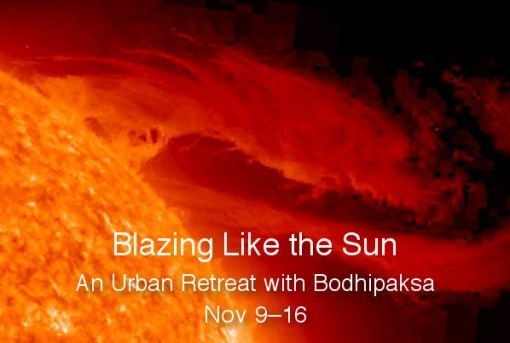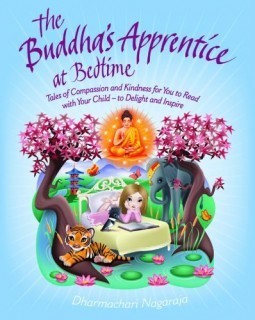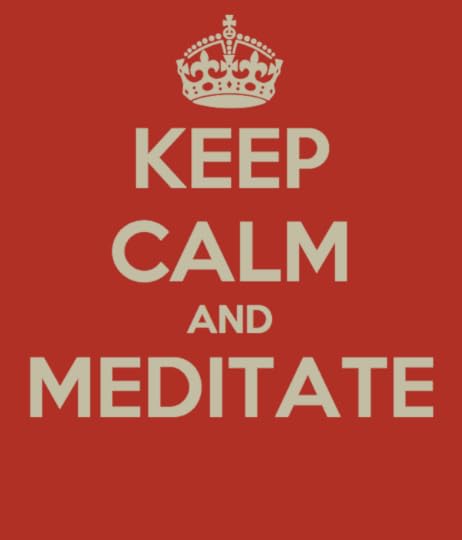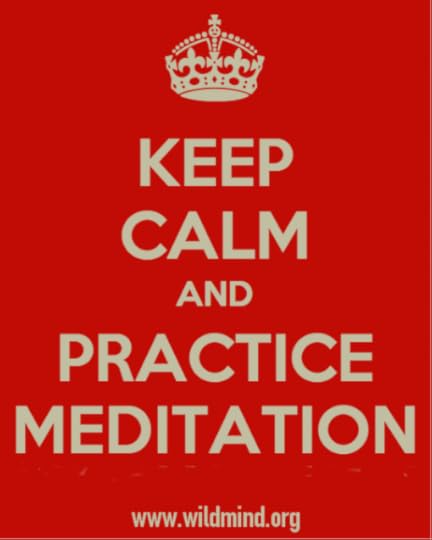Bodhipaksa's Blog, page 21
November 26, 2013
The Urban Retreat: Every ending is a beginning

This is not the end, but the beginning.
Here is a summary of where we’ve been, and a list of suggestions for continuing your exploration of meditation.
Where we’re been
We hope you appreciated and benefited from the material we sent you. Remember that even if you didn’t manage to read everything or watch all the videos, they’re always there for you. In fact here’s a handy list of all the posts we sent during the retreat:
Urban Retreat: Day 1: Demystifying lovingkindness
Urban Retreat: Day 2: Authentic lovingkindness
Urban Retreat: Day 3: Lovingkindness: When the Rubber Hits the Road
Urban Retreat: Day 4: Protecting others, you protect yourself.
Urban Retreat, Day 5: Looking with loving eyes
Urban Retreat, Day 6: The tender heart of lovingkindness
Urban Retreat, Day 7: The practice of gratitude
Urban Retreat, Day 8: Developing compassion
And there were three guided meditations that we led as part of the event. You can access those anytime, here:
Urban Retreat Lovingkindness Meditation #1
Urban Retreat Lovingkindness Meditation #2
Urban Retreat Lovingkindness Meditation #3
What’s next?
If you want to maintain and deepen your meditation practice and, perhaps, your practice of Buddhism more generally, here are a few options:
1. Wildmind’s Year of Going Deeper
Our Year of Going Deeper is a year-long series of meditation events, where we’ll explore various aspects of meditation. It’ll be like the Urban Retreat, but with more of a sense of community. There are eight events planned, spanning the whole of 2014. Some are introductory, while others are more in-depth. All the events are free, although donations are encouraged. Click here to learn more about the Year of Going Deeper.
2. The World in Balance, March 20, 2014
The World In Balance is a special event we’re running on the March equinox: March 20, 2014, at 16:57 UTC (click on the link to add the event to your calendar in your local time). It’s a worldwide meditation event, taking place at the exact moment that the earth’s equator passes the center of the sun, the earth is perfectly upright, and the transit from the seasonal extremes is at a balance point worldwide — but at the moment the details of the event are a secret! All we can tell you now if that it’s going to be big. Sign up for our special World in Balance newsletter and we’ll reveal the secret in due time! (There won’t be many mailings.)
3. Join Wildmind’s Community on Google Plus
Our community is the most civilized, sane, compassionate place you’ll find for discussing your practice, and for getting support and encouragement. Join here.
4. Subscribe to Wildmind’s regular, bi-monthly newsletter
Our regular newsletter goes out roughly every two weeks, and contains links to selected news and articles from our blog. As of the next newsletter, there will also be a special article in each edition that hasn’t been published on our blog. Sign up here.
5. Join us for a weekend retreat
Bodhipaksa will be leading a retreat in Florida (just south of Tampa) from Feb 21–23, 2014. You can find out more or register here. There will also be a weekend retreat in southern New Hampshire, May 2–4, 2014. To find out more, subscribe to our newsletter!
6. Make use of other Triratna resources
Free Buddhist Audio is a treasure-trove of audio and written resources on the theme of Buddhist practice. The Buddhist Center is Triratna’s central site, which you can use to find a Triratna Center near you, or to find other resources.
7. Help us to spread the benefits of meditation
Lastly, we’re put a lot of work into this Urban Retreat. How about giving something back, by making a donation of $5, or $10, or even $20? We have a special fundraising project at the moment called the Free Bodhi Fund, which will help us to employ more staff so that Bodhipaksa can be freed up from admin and concentrate on teaching. You can contribute to the Free Bodhi Fund here. Oh, and donors can opt to receive perks as rewards for their donations!
May you fare well in the future, and may our paths cross again.
Yours,
Bodhipaksa
Related posts:
Join the Urban Retreat, Nov 9–16
The Urban Retreat, Day 5: Looking with loving eyes
The Urban Retreat on Wildmind (Nov 9–16)
Related posts brought to you by Yet Another Related Posts Plugin.

November 25, 2013
Oldest Buddha Shrine Dates Birth to 6th Century B.C.?

Oldest Buddha Shrine Dates Birth to 6th Century B.C. : DNews
Buddha’s birthplace has been found and dated to the 6th century B.C., providing direct evidence for the nativity story of the Buddha himself. Continue reading ?
Related posts:
Christianity ‘could die out within a century’ – Telegraph
Robert A. Heinlein: In Dialogue with His Century
Visiting Maia’s birth family
Related posts brought to you by Yet Another Related Posts Plugin.

“The Buddha’s Apprentice at Bedtime,” By Dharmachari Nagaraja
 Available from Amazon.com and Amazon.co.uk.Three years ago I walked into a bookstore in Vancouver, where I was doing a book launch, and literally the first book spine that caught my eye in the Buddhist book section was called Buddha at Bedtime. As the father of two young children I pulled it from the shelf with excitement, and was astonished to discover it had been written by an old friend of mine from my days in Glasgow.
Available from Amazon.com and Amazon.co.uk.Three years ago I walked into a bookstore in Vancouver, where I was doing a book launch, and literally the first book spine that caught my eye in the Buddhist book section was called Buddha at Bedtime. As the father of two young children I pulled it from the shelf with excitement, and was astonished to discover it had been written by an old friend of mine from my days in Glasgow.
Of course I got a copy of the book, and it’s been a bedtime fixture in our household ever since. Now comes a much-welcomed sequel, The Buddha’s Apprentice at Bedtime.
As with the first volume, The Buddha’s Apprentice contains adaptations of traditional “Jataka” tales, which are Indian fairy tales that tell of the previous lives of the Buddha. Each tale illustrates a particular virtue, in a similar way to the Fables of Aesop, which draw on the same body of folk tales (Indian and Greek cultures have a historical connection).
The stories have been updated in order to make them more accessible, and are no longer presented as the past lives of the Buddha. In a way that’s actually more accurate, since these would have originally been non-Buddhist tales. In fact the Buddha isn’t mentioned in the stories, nor are they all set in India. Although some of the settings are (from a Western point of view) exotic, they quite are multicultural, taking place in locales as disparate as jungles, deserts, the Scottish Highlands, Thailand, and, of course, India.
The names, unless the stories are explicitly set in a foreign land, are westernized. For example, one story features Rosie (a tough girl, who injures a rabbit), Hazel (who nurses the rabbit), and their teacher Miss Poppy. This makes the experience for both the reader and the average child much easier than struggling though Sanskrit names such as Siddhartha and Devadata. Additionally, in the tale of Rosie and Hazel the genders of the characters have been changed as well, so that we end up with more female protagonists than there are in the traditional tales. Since moral truths are universal, and not dependent on gender, this tweak to the originals is a valuable way of making the stories, and the lessons they contain, accessible to all children.
And as with the first volume, this is a delightful read. The stories are exceptionally well-written and a delight to read out loud. Nagaraja is a skilled storyteller.
The illustrations, by the very talented Sharon Tancredi, are luminously colorful, and the characters exude abundant personality. At first I thought I preferred the illustrations in the original book, but actually these are every bit as good, and in many ways the facial expressions are more “alive” than in the original Buddha At Bedtime. Some of the elements — mainly the monkeys’ faces, and those of some of the other animals — seem a bit child-like for my taste, but on the whole the images are delightful.
My seven-year-old daughter certainly doesn’t find this book too childish, nor did my son, at age four, find it too grown up. I’d guess that a good age-range for The Buddha’s Apprentice would be three to eight.
One thing I was pleased about is that the Buddha, who is illustrated at the end of every tale delivering a brief moral punchline, is now actually the Buddha. In the first book the illustrations were of Budai, who is the fat Chinese monk (often called the “Laughing Buddha”) who you’ll have seen in many a Chinese restaurant. It’s a common thing for westerners to assume that Budai is “the” Buddha (i.e. the historical Buddha, Shakyamuni) even though this is rather like confusing Christ and Santa Claus! As well as being more culturally accurate, the use of the serene and dignified figure of Buddha Shakyamuni seems more proper, and many Buddhist parents will be inclined to take the book just a little more seriously.
The book contains some meditation instructions for children, which I confess I haven’t tried with my own kids. The inclusion of meditation instruction for children gives another good reason for buying this book. There’s just not enough of that kind of material in circulation.
The ultimate reviewers of a book such as this, though, are the children. Mine love it! And I’m sure yours will too. Remember, Christmas is coming!
Related posts:
A Buddhist blog by kids, for kids
Writing about Bodhisattvas
The Peaceful Crusader – New York Times
Related posts brought to you by Yet Another Related Posts Plugin.

The Urban Retreat, Day 8: Developing compassion

I’m going to write less today, because sometimes I go on a bit, and I know we’re all bombarded with information. So here are just a few words about the practice of compassion, and especially of self-compassion.
What is compassion? Like lovingkindness, it’s a volition (something we desire or will or intend). While lovingkindness is the desire that beings find happiness, compassion is the desire to relieve suffering. Compassion flows directly from lovingkindness; we want beings to be happy, yet they suffer, and so we want their suffering to be relieved so that they can find happiness.
Compassion is not a sentiment. It’s not just a feeling. Volitions are what lead to actions, and so the volition of compassion will lead to us relieving suffering where we’re able to. You can be compassionate without feeling much!
It’s hard to have compassion for others when we don’t have it for ourselves. Just as the lovingkindness practice starts with kindness toward ourselves, so compassion starts with — well, if we’re not currently suffering then it starts with kindness toward ourselves, but if we are suffering then we often need to address our suffering before we are able to have compassion for others, so we start with self-compassion. This isn’t selfish — it’s like how in airplanes you’re asked to put on your own oxygen mask before you help your children. If you don’t take care of your own needs first then you won’t be able to help your kids.
Suffering isn’t always what you think it is. A lot of people think they don’t suffer. They thing suffering is what poor people and sick people and people in third world countries do. Suffering is having cancer or starving to death. Actually, those things are suffering, but so is worrying about whether people like you, or feeling grumpy, or wishing you weren’t at work, or feeling low and despondent. Now it’s suffering on a different scale, but it’s still suffering, and it still matters. If we care about someone’s wellbeing we want them to be free of all suffering.
We often don’t notice we’re suffering when we’re suffering. We’re too caught up in worrying that people might not like us, for example, to notice that in that moment we’re in pain. So we have to learn to recognize our own suffering.
And when you find yourself in emotional pain in the ways I describe, it’s very valuable — crucial, even — to treat your pain with lovingkindness. You haven’t failed by suffering. It’s not a sign of weakness. It’s a sign of being alive and human. So accept your suffering. Accept that it’s OK to suffer. Say to yourself “It’s OK to feel this.”
And then wish your suffering well. By doing this you’re wishing the part of you that is suffering well. Here’s one way to do that:
Notice where in the body your pain is most strongly located. (Even emotional pain is located in the body.)
Accept the pain. “It’s OK to feel this.”
With gentle curiosity, notice the pain’s size and shape and texture.
Place a hand on the part of part of your body where the pain manifests.
Say, like an adult to a child, “I know you’re in pain; I love you, and I wish you well.”
If the pain has arisen in response to the actions of other people — for example someone may have said something you found hurtful — then call them to mind now. Recognizing that they, too, suffer, you can wish them well: “May you be free from pain; may you be free from fear; may you find peace.”
Related posts:
The Urban Retreat, Day 6: The tender heart of lovingkindness
The Urban Retreat, Day 2: Authentic lovingkindness
Developing compassion: instructions from an ancient source, plus commentary (Day 32)
Related posts brought to you by Yet Another Related Posts Plugin.

November 24, 2013
The Urban Retreat, Day 7: The practice of gratitude

One quality that’s closely related to metta is appreciation. We often take things for granted when they’re going right, and then focus on what’s not going the way we want it to. And that makes us unhappy and makes our relationships with others less warm and appreciative.
At our worst we’ll say things like “Nothing ever goes right in my life.” And in the moment we’re saying those words we’ll ignore that we have air to breathe, we’re alive, we’re probably healthy, we’re living in a fairly civilized society (it’s far from being Mogadishu), we’re sheltered from the elements, we have water, electricity, the internet, friends, family, etc. The specifics of what we have change from person to person and day to day, but we always have a lot more going for us than we choose to appreciate.
So one thing I do in my practice sometimes (and this is something I explore in the video below) is to consciously appreciate what’s going right, and to say “thank you.”
I’ll take a trip around the body, basically doing a body scan meditation, and say “thank you” to each part of the body in turn. I’ll thank my feet, legs, hips, abdomen and lower back, chest and upper back, throat, head. I’ll thank my heart and lungs and other organs. I’ll thank my senses. If some part of the body isn’t functioning well, then rather than give it less thanks, I feel especially grateful; the body shows up for you every day. It tries its best to serve you even if it’s not well or damaged. It’s always trying to heal and repair itself. That’s the best kind of friend you can have — one who turns up to help you even when they’re sick.
And I appreciate and thank everything around me, from the furniture I’m sitting on (think of all the people involved in making it possible for you to do something as simple as sit on a chair!), to the building I’m in and all the utilities in it, to the society around me with its roads and sidewalks and sewers.
You can thank the air for being breathable. You can thank the sun for shining. Really, there’s no limit to the things we can express gratitude towards.
And as you do this practice (I assume you will) notice how you feel. There may be some initial resistance (it may seem silly to say thank you or you may not want to acknowledge your dependance upon others) but when you get into the practice of saying thank you you may start to notice a sense of warmth, or softness around the heart, or even joy.
If the video isn’t displaying (which can sometimes happen on mobile devices) then you can go straight to Youtube.
Related posts:
The Urban Retreat, Day 2: Authentic lovingkindness
The Urban Retreat, Day 1: Demystifying lovingkindness
The Urban Retreat, Day 3: When the rubber hits the road
Related posts brought to you by Yet Another Related Posts Plugin.

November 23, 2013
Push back against the War on Thanksgiving
Why I don’t shop at Walmart.
As the person who shared this with me on Google Plus said, “Funny how Fox News brings up the fake “war on xmas” every year, but conveniently ignore the real war on Thanksgiving.”

Related posts:
Happy Thanksgiving
Fighting a Workplace War Against Distraction
Make Diplomacy, Not War
Related posts brought to you by Yet Another Related Posts Plugin.

The Urban Retreat, Day 6: The tender heart of lovingkindness

In previous posts I’ve suggested an approach to cultivating lovingkindness that begins with contacting our innate lovingkindness. Now the expression “contacting our innate lovingkindness” is a problem for many people, because they look inside themselves, don’t see anything at that moment that they could call “metta” or “lovingkindness,” and then conclude they don’t have these qualities. Which can start a downward spiral of rumination and pain: I don’t feel any love; Therefore I don’t love myself; Therefore I must be unlovable; Therefore no one will ever love me; Therefore my life is horrible.
I think almost everyone has experienced that kind of emotional nose-dive at one time or another.
But I think that when this happens we may be looking within in the wrong way, and for the wrong thing.
I think the potential for lovingkindness is always there. It’s an innate part of us. But we have to awaken it. It’s sleeping, dormant. It’s wrapped in blankets of denial and self-protection.
And my current approach to awakening our innate ability to be kind is one I’ve mentioned before: a pair of simple reflections, followed by an invitation.
So the first reflection is this: We drop into the mind the truth, “I want to be happy.” I’m presenting this as a truth, because I believe that deep down we all do want happiness. Even when we choose a destructive path that leads to pain, we’re doing this because we believe it will bring happiness, or at least a relief from suffering, in the long term. It won’t, of course, but that’s because we’ve chosen the wrong strategy to find happiness, not because we don’t want to be happy.
So we drop this statement — “I want to be happy” — into the mind, and let its truth resonate within us. Feel its truth in your life, not in an abstract way, but concretely: “Yes, it’s true. I do want happiness. Even in this moment I want happiness.” This may be experienced as a kind of tender ache, and that’s OK. We’ll get back in a moment to why that’s OK.
And the second reflection is this: “Happiness isn’t always easy to find.” So we drop that thought — that truth — into the mind in the same way, giving ourselves time and space to have a response to it, to sense the truth of it in our lives. Because this too is true. We want happiness, but happiness is often elusive. We keep expecting to be happy and it doesn’t happen. Happiness doesn’t arrive, or it passes too quickly, or unhappiness shows up instead. So this too many evoke an achey sense around the heart. That’s good. Again, we’ll come to the why in a moment.
The invitation that follows these two reflections is just this: there is some part of you that, realizing that you want to be happy and that happiness is elusive, is prepared to wish you well. There is a part of you — a very deep part of you — that is prepared to be kind and supportive as you go about this difficult thing we do — being human.
Because I think it is generally harder than we admit, this being human. Having this innate drive for happiness in a world in which happiness is hard to find is a tough thing to do. And happiness doesn’t necessarily mean going about with a smile plastered on your face. Yes it can mean joy, but it can also be meaning, purpose, satisfaction, connection, or peace.
And the ache I talked about, which comes, often, when we rediscover that we want to be happy and when we admit that it’s hard to do this, is very valuable. Because this feeling of vulnerability is the recognition of the truth of our existential situation, and it’s not until we recognize our desire for happiness and the difficulty of attaining that desire that we can be truly supportive of ourselves.
Often we don’t admit this truth, and we believe we have our lives “sorted.” We’re fine. Maybe we don’t admit that we’re not too happy right now. That would be an admission of weakness and failure! Or maybe we do grudgingly admit that things aren’t perfect right now, but once we lose that 10 pounds, or get that promotion, or get past this busy spell at work — well, then we’ll be happy. We can become a bit cold and hard, and judgmental. When we see others being unhappy, rather than feel sympathy for them we may feel contempt. Or if we’re magnanimous we may give them some advice: “You just need to…” Have you noticed how prone we are to give advice on how to be happy even when we’re not happy ourselves? How sure we are that we have it all figured out, even when clearly we haven’t? And when people are at their most alienated from their vulnerability, they can be cruel. It becomes enjoyable to watch someone else fail; it confirms that that person is weak — unlike us.
When we allow ourselves to be vulnerable (“Yes, I do want to be happy; yes, it is hard”) all this protectiveness is dropped, and we discover that we do want to support ourselves. We do want to be kind to ourselves as we do this difficult thing of being human. We do have innate lovingkindness and we have just contacted it. And it’s a bit achey, but that’s just what happens when we rediscover our deeper needs, and when we admit the difficulty of meeting them.
And then when we turn our attention to others and recognize that they are in the same situation as us — that they are struggling beings, desiring happiness but finding it elusive — we find that the vulnerability opens the way to a tender sense of kindess toward them: a heart-felt desire to wish them well as they do this difficult thing of being human.
So try this as a practice for the next few days, at least. When you meet other people, or see them on TV, or think about them, remember that this is another being who wants to be happy, and who finds happiness elusive, who wants not to suffer and finds the suffering comes visiting all too often. Try this and see how it affects your sense of yourself, and your attitude to others. Try this also when you become aware of yourself — particularly when you find life hard or frustrating or unsatisfying. Recollect that you want to be happy, and that happiness isn’t always easy to find. Accept the tender sense of vulnerability that comes with that awareness — and wish yourself well.
This is what “contacting our innate lovingkindness” means. It’s not looking inside and finding some pre-made emotion of love. It’s finding a way to our own achey, tender vulnerability, and letting the heart respond with kindness.
Related posts:
The tender heart of lovingkindness (Day 22)
The Urban Retreat, Day 2: Authentic lovingkindness
The Urban Retreat, Day 1: Demystifying lovingkindness
Related posts brought to you by Yet Another Related Posts Plugin.

November 22, 2013
Keep Calm and Practice Meditation
Related posts:
Listening as a meditation practice
Guided meditation: The six element practice
When your meditation practice doesn’t seem to be going anywhere…
Related posts brought to you by Yet Another Related Posts Plugin.

Keep calm and meditate?

Keep calm and meditate?
Related posts:
Hardwiring Happiness: The New Brain Science of Contentment, Calm, and Confidence
Don’t Hesitate: Meditate
“I meditate every day. It’s just what I do. It’s part of who I am.”
Related posts brought to you by Yet Another Related Posts Plugin.

The Urban Retreat, Day 5: Looking with loving eyes
I’d like to share a way of relating that I call “loving gaze.” This is borrowed from Jan Chozen Bays, who writes in How to Train a Wild Elephant of the practice of “Loving Eyes.”
In her book she says:
We know how to use loving eyes when we are falling in love, when we see a new baby or a cute animal. Why do we not use loving eyes more often?
So what we can do is to recall, or even just imagine, the experience of looking with loving eyes. You can recall (or imagine) looking at a beloved child, or a lover, or even a pet. I find that the sense of care, and appreciation, and non-judgement is very transferrable, so once you’ve evoked a loving gaze you can turn that sense of looking lovingly upon yourself. As you notice the body, your breathing, your thoughts, etc., you can look at them with loving eyes.
And once you’ve evoked that for yourself, you can now turn your loving gaze upon others: friends, people you don’t know, people you have difficulty with, animals, all beings…
This, I find, is a very quick way to help lovingkindness to emerge.
And when we do this, everything we experience seems to become gentler and softer. The world appears to be a lovelier, sometimes heartbreakingly beautiful, place. Even the ugly bits of life seem beautiful in their ugliness. And we start to realize that the world is our experience of the world, which is not separable from ourselves. And so when we change, the world we perceive changes too. The world of our experience becomes more loving, more tender.
There’s something Chozen says about this that always blows me away:
Seeing with loving eyes is not a one-way experience, nor is it just a visual experience. When we touch something with loving eyes, we bring a certain warmth from our side, but we may also be surprised to feel warmth radiating back to us. We begin to wonder, is everything in the world made of love? And have I been blocking that out? [Emphasis added]
Give it a try, both in your sitting practice and as you go about your daily life. You can start right now, as your eyes scan the words in front of you. Look with love. And then carry that loving gaze into your next activity.
Additionally, here’s a recording of the first guided meditation hangout that we did as part of our Urban Retreat:
If that doesn’t work for you (which is sometimes the case on mobile devices) then here’s a direct link to Youtube.
Lastly, If you appreciate the work that's gone into our Urban Retreat, please contribute to our Free Bodhi project. Our plan is to set up a year-long series of opportunities to explore meditation, from the basics up to insight. We're calling this our Year of Going Deeper, but we can't do it without your help.
Related posts:
Looking with a loving gaze (Day 3)
Join the Urban Retreat, Nov 9–16
The Urban Retreat, Day 1: Demystifying lovingkindness
Related posts brought to you by Yet Another Related Posts Plugin.





